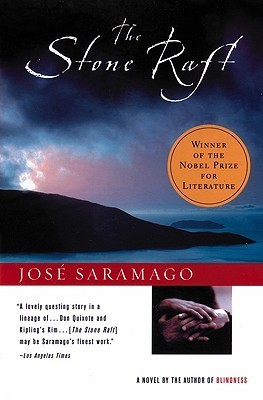
The Stone Raft
Book Description
When the Iberian Peninsula breaks free from the European continent, a ragtag group of people finds themselves on a floating landmass, embarking on a journey that will challenge their beliefs and unravel their identities. As tensions rise, alliances shift, and secrets surface, the characters confront their deepest fears and desires amidst the chaos of a world turned upside down. Love blooms against all odds, while the specter of humanity’s choices looms over them. In this surreal tale of survival and connection, can they forge a new existence on the flowing stone, or will the weight of their past drown them?
Quick Book Summary
"The Stone Raft" by José Saramago is a magical realist novel that begins with the Iberian Peninsula breaking away from Europe, physically separating Spain and Portugal from the continent. As this landmass drifts aimlessly across the Atlantic, a disparate group—including Joana, Joaquim, José, Maria, and Pedro—are drawn together by strange coincidences and a shared sense of displacement. Their journey across the transformed landscape becomes an exploration of identity, belonging, and human connection. Amidst uncertainty and the chaos of a world upended, they form bonds of friendship and love, while reflecting on the histories and choices that have shaped their lives. Saramago weaves humor, allegory, and philosophical inquiry, using the characters’ odyssey to probe questions of nationalism, solidarity, and the search for meaning in an unpredictable world.
Summary of Key Ideas
Table of Contents
Isolation and National Identity
The story opens with the inexplicable breakage of the Iberian Peninsula from mainland Europe, setting the stage for the novel’s allegorical exploration of isolation and national identity. As Portugal and Spain float across the Atlantic Ocean, both countries are thrust into an uncertain position, their peoples’ sense of selfhood and belonging tested by geographic and metaphysical displacement. Saramago’s narrative investigates how borders, both literal and psychological, shape communities and the perception of nationhood.
Human Connection and Solidarity
Amid the chaos, a motley group of individuals comes together: Joana Carda, Joaquim Sassa, José Anaico, Maria Guavaira, and Pedro Orce. Each has experienced a peculiar event that hints at the magical realism underlying the novel—stones hurled impossibly far, visions of disruption, or sudden animal migrations. These strangers create a surrogate family as they travel across the drifting peninsula, discovering solidarity in the face of shared adversity. Through mutual aid and the forging of new relationships, their journey is as much about self-discovery as it is about collective survival.
Surrealism and the Absurd
Saramago’s surreal vision employs absurdity and humor to highlight the unpredictability of existence. The floating landmass becomes a metaphor for the instability of human life and the abruptness with which the familiar can become strange. The author’s signature narrative style—long sentences, minimal punctuation, and a wry omniscient voice—invites the reader to experience the world’s transformation through the eyes of his bemused, reflective protagonists. The journey teems with bizarre and improbable occurrences, reinforcing the magical realist tone.
Political and Social Critique
The drifting of the peninsula triggers geopolitical anxieties among Europe’s nations, prompting governments to respond with suspicion and self-interest. Saramago uses these reactions to satirize political tensions, historical grievances, and the fickleness of alliances. The media frenzy and governmental maneuvers serve as a critique of bureaucracy and nationalism, highlighting both the comic and tragic dimensions of global politics when confronted by the inexplicable. The characters’ odyssey thus doubles as a commentary on the artificiality of borders and human-made divisions.
Transformation and Adaptation
As the characters navigate the upheaval, the journey becomes a transformative process for each of them. They confront their personal histories, challenge ingrained orthodoxies, and adapt to their new reality. Love stories and friendships blossom amid the uncertainty, showing that even in the most surreal situations, humanity persists through empathy and connection. Ultimately, "The Stone Raft" is a meditation on resilience, the reinvention of identity, and the enduring need to find one’s place in a shifting world.
Download This Summary
Get a free PDF of this summary instantly — no email required.





